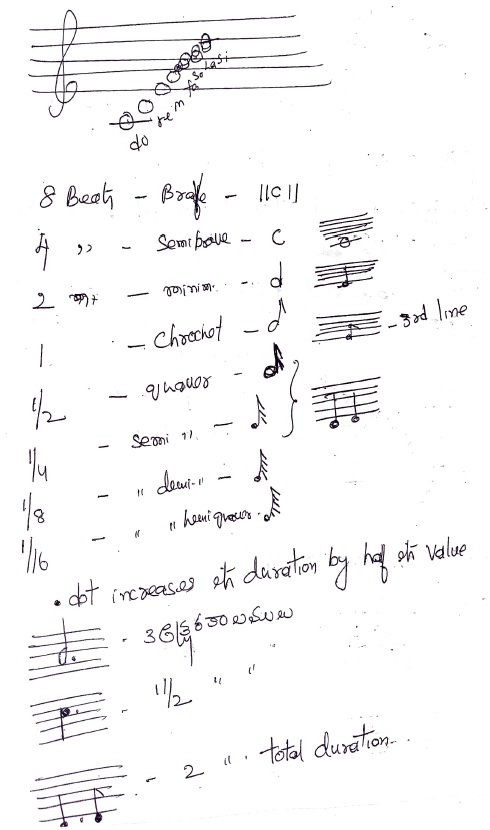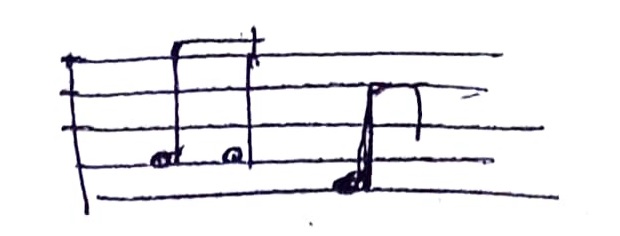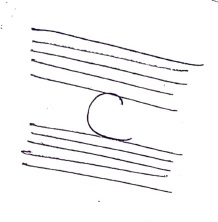[శాస్త్రీయ సంగీతంను పరిచయం చేస్తూ డా. సి. ఉమా ప్రసాద్ అందిస్తున్న ప్రత్యేక వ్యాస పరంపర..]

అధ్యాయం 31 – రెండవ భాగం
Duration of the Notes:
Duration of the Notes is like below image.

Continuous Sound ని tie (or) bind చేయాలన్న

Time Signature:
తాళమును టైమ్ సిగ్నేచర్ బార్ ద్వారా సూచించవచ్చు. The bar అనే complete ఆవర్తం రూపక తాళములో, చాపు, ఝంపె, త్రిపుట and 2 1/4 the half ఆవర్తం in ఆదితాళ. 3/2 indicates రూపకతాళ 3 minims to a bar.

4/4 or 2/2 indicates the piece in ఏకతాళ (చం॥ జాతి) and that there are 4 crotchets (or) 2 minims to a bar. Lower figure – unit ని indicate చేస్తుంది.

The phrase do cap6 (or) D.C. at the end of అ॥ప॥ చ॥ indicates that the 𝅘𝅥| should be sung (or) played one again without repetition from the beginning till fine.
Absolute pitch and time western music లో వుంటుంది.
Relation pitch and time Carnatic Music లో వుంటుంది.
ఎక్కువ, తక్కువ sounds western music end లో వున్న portion effect కోసం, tempo కోసం, perform చేస్తారు. మన సంగీతంలో లయ, శ్రుతి, శుద్ధ, uniformity in tempo maintain అవుతుంది.
Writing Indian Melodies Staff Notation – Some Problems:
- స్వరములు straight notes – western music లో long notes – vibrato – vibration లో వుంటాయి. మన భారతీయ సంగీతంలో ఉండే composition – శం॥ లో ‘మరియాద గాదుర’ అనేది Indian Music లోని song western musicians play చేయడం కష్టం. దానిలో ట్రైనింగ్ తీసుకుంటే westerners మన music ని వాయించగలరు.
- Piano లో equal temperament that can’t visualise that in Indian music. The scale of just notation alone is used. Violists solo perform western లో ఇచ్చినప్పుడు just notation that is natural intonation.
Harmonising Indian Melodies:
మన music లో harmony తీసుకురావడం చాలా కష్టంతో కూడిన పని. Delicate శ్రుతి, graces తీసుకురావడం చాలా కష్టం. Slightly flat, slightly sharp in ఆరోహణ, అవరోహణ గాం॥ in తోడి రాగ of South Indian music is good example. Its frequencies in the two phrases Grs and Mm ggm are different harmonising melodies in వర్జ్య రాగాలు like mohan లాంటివి. కనుక they will sound as అపస్వరాలు in raga.
The Advent of Staff Notation:
19th century కి ముందే staff notation దక్షిణ భారతీయులకు తెలిసింది. బాలస్వామి దీక్షితార్ staff notation తెలిసినవారిలో ప్రసిద్ధుడు (1786-1858). తరువాత Schwartz మహరాజు Serfojee of Tanjore ద్వారా staff notation నేర్చుకొనెను. Band music notes మీద వాయించుటకు వీలుగా కొన్ని melodies staff notation లో వ్రాసారు. మహారాజు book లో melodies అన్ని notation లో వ్రాయబడి ఇప్పటికీ తంజావూరు సరస్వతీ మహల్ లో ఉన్నాయి.
Palace Salam అనేది March లో వ్రాసిన composition, 23rd August 1803 గా చెప్పబడింది. New Quick Step composed by M. M. Serfojee Maharaj on 23rd August 1803 is also given staff notation 1828 year లో staff notation pieces band లో వాయించేవారు.
Compositions are:
| Slow March | -Flutes in F
-4th Dragoon Guards Flutes in G |
| Quick Step | -4th Dragoon Guards Flutes in G
– Flutes in C |
| Slow March | – Flutes 1st in B |
| Quick Step | – Flutes 1at in E flat |
Like that so many compositions are there. 1st quarter of 19th century లోనే Indian musicians కి staff notation compositions తెలిసాయి అనుటకు గల తార్కాణం, 1st composer మహరాజా Serfojee western music లో రాయడం.
Adoption of the Staff Notation:
Needed symbols that represents music accurately on paper: చిన్నస్వామి మొదలియార్ South Indian classic melodies ని staff notation ద్వారా మెరుగులు దిద్దారు. Sharp and flat bar indicates flat and sharps taken by a particular raga and has nothing to do with the key-signature as such. Oriental Music in European notation was published in 1892. T. M. Venkata Sastri in 1892 published సంగీత స్వయంభూ ధ్వని with మధ్యమ కాల and త్రికాల lines indicate the time values of the notes. He also used the sharps and flats signs to indicate అన్య స్వరాలు in భాషాంగ రాగాలు like కాంభోజి.
In 1920 book ‘Ragas of Tanjore’ containing classical Krithis of Tyagaraja and other composers was published in staff notation. Dr. Rajah Sir Sourendra Mohan Tagore was the earliest author to publish Indian melodies in staff notation. In 1878 – 50 tunes staff notation invent చేశారు. 1879లో జయదేవుని అష్టపదులను కూడా staff notation లో వ్రాశాడు. మహారాజా ధర్మపురి 2 Volumes of the Ragas published in Hindustani Music in staff notation.
Staff:
- 5 parallel lines and 4 spaces between those lines and upon which the notes are placed lines counted upwards, lowest being the first.
- Great Staff: 2 Sets of 5 parallel lines with a separate line for the middle ‘c’ in between

Soprano and Alto on the above
Tenor and Bass on the lower set of 5 parallel lines.
Ledger Lines:
Short lines added above (0r) below the staff as shown in the image below.

Sa or the tonic can be on any line or space, but in in Indian music, it is always written on the line, representing the middle C for convenience.
(ఇంకా ఉంది)
















